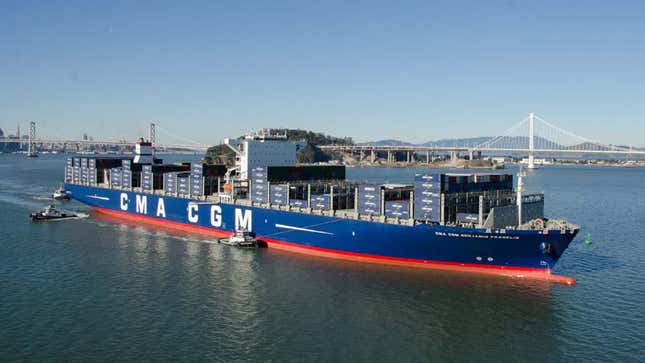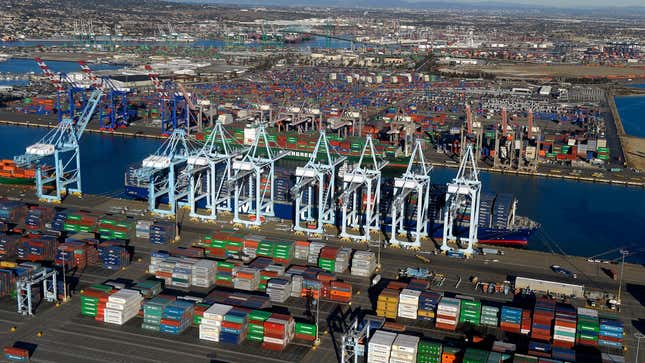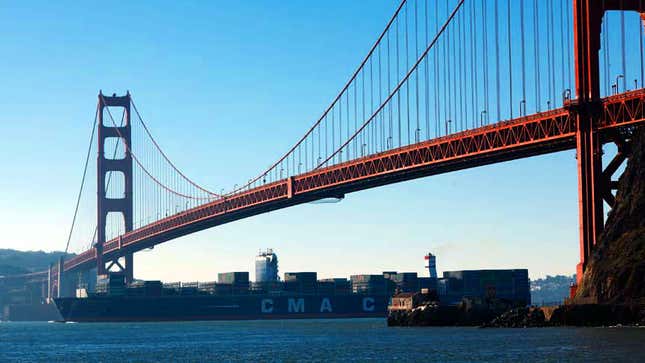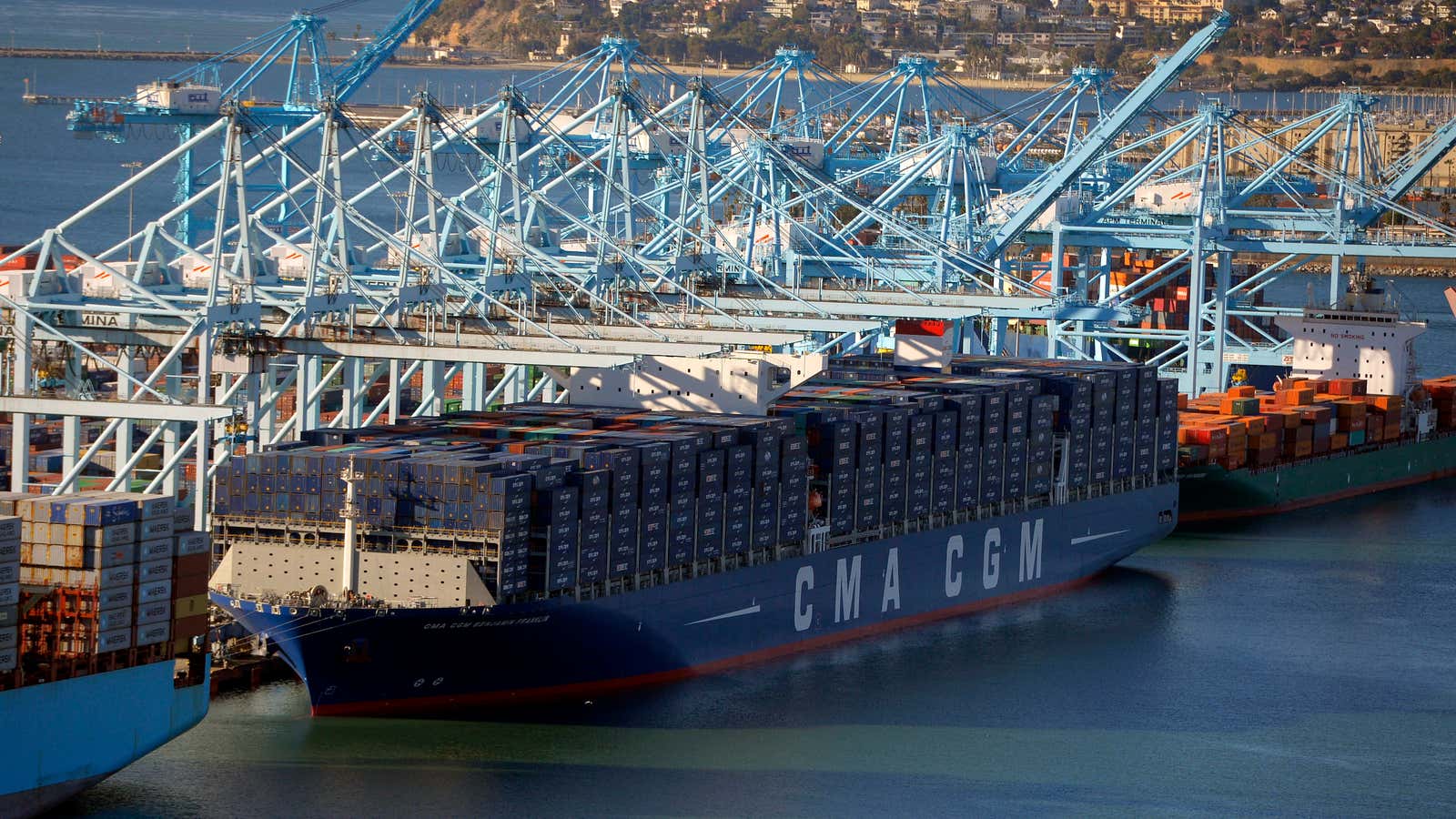The CMA CGM Benjamin Franklin is 396 meters long and 54 meters wide, longer than the Empire State building is tall and wide as half a US football field. Crewed by 26 people, it can carry the equivalent of 18,000 standard cargo containers for a net tonnage of 116,000.
In previous weeks, it became the largest vessel to ever visit the United States, with stops at two California ports—but is it evidence of a glut of mega-ships destined to overwhelm the industry?
Shipping analysts fear that the answer is yes—but shipping companies say that the only way to survive competition is to go big. Just a few years ago, the Benjamin Franklin would have been the largest in the world, but now a ship carrying 19,200 standard containers is in operation, and 21,000 TEU container ships are already in production.

Container trade is at the heart of the modern economy, the key link in the world-spanning supply chains of manufactured goods and commodities. The ports where their goods are offloaded are infrastructure marvels where massive cranes and robotic chassis pull thousands of huge metal boxes from ships and place them on trucks and rail cars to plunge into the interior.
The pressure on shippers to offer lower and lower rates led to something of an arms race for super-massive, super-efficient ships—the Benjamin Franklin is “by far the most efficient and least polluting mode of transportation, if I’m not mistaken, it’s 70 times less what an airplane would do,” Marc Bourdon, president of French shipper CMA CGM’s US subsidiary, told Quartz.
But the slowed growth of trade following the Great Recession has led to over-capacity that may drive down prices below the point of survival for some in the industry. Consulting firms like BCG and McKinsley have argued that the debts behind these major ship purchases will lead the $6 trillion industry into consolidation or alliances among major shippers such as CMA CGM, Maersk Moeller and MSC. Some of these problems are coming home to roost in the shipbuilding industry itself, with one state-backed Chinese firm filing for bankruptcy at the end of 2015.
“Our research casts serious doubts over whether this capacity can in fact be filled,” the International Transportation Forum’s Olaf Merk wrote in 2015. “We found a disconnect between what is going on in the boardrooms of shipping lines and the real world. The growth of containerized seaborne trade is no longer in line with the growth of the world container fleet.”
Among the problems that Merk foresees is gridlock in ports: Mega-ships require significantly larger infrastructure, from deeper channels to bigger cranes, and the sudden injection of goods can overwhelm local transit infrastructure. When the Benjamin Franklin arrived at the Port of Los Angeles—the busiest in the US—it took two weeks to prep the logistics for unloading, normally a two or three day job.

The ship’s landfalls in LA and in Oakland were about more than cargo delivery; they were a demonstration intended to prepare US ports to upgrade their facilities and practices to handle mega-ships regularly. Los Angeles is the only port in the US that can handle a ship of that size at full capacity, though Oakland and the Port of Long Beach are not far behind. Mega-ships like these typically ply the Asia to Europe route, stopping at ports such as Shanghai and Ningbo in China or Le Havre in France and Rotterdam in the Netherlands.
Upgrading to handle the mega-ships will be costly, and will have cascade effects as somewhat-smaller ships in the 14,000-container range move to routes in Africa and South America, forcing upgrades there. All in all, Merk’s research projects “a decade of port gridlock” that would raise shipping prices on land enough to make the seaborne savings neglible. And that’s before you get to the increasing cost of insuring so much cargo on just one ship.

But for the largest shippers, scale is the answer to scale’s problems. The Benjamin Franklin is one of six 18,000 container ships in the CMA CGM’s fleet.
“Over-capacity is always a concern for anybody in the industry, it does impact the economics,” Bourdon says. “However, what impacts the economics even more is scale. And that’s the result of rates being constantly under pressure—you look historically, there is a situation of freight rates in markets depending on seasonality and cargo rush and so on, activity that you can only withstand through scale. If you look at, for CMA CGM, our strategy around larger vessels that started quite a number of years ago, we can reasonably say that for us it paid off.”
Bourdon says the company is not sure whether it will add to its fleet of mega-ships, but he is hopeful that the Benjamin Franklin will return to the US for a second demonstration trip to the Port of Long Beach and to Seattle.

